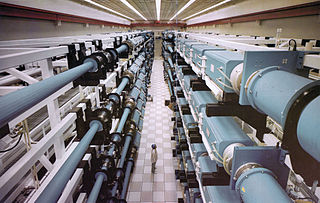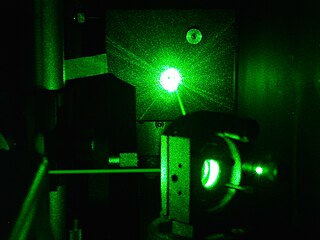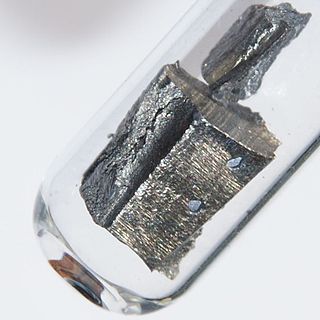
Inertial confinement fusion (ICF) is a type of fusion energy research that attempts to initiate nuclear fusion reactions by heating and compressing a fuel target, typically in the form of a pellet that most often contains a mixture of deuterium and tritium. Typical fuel pellets are about the size of a pinhead and contain around 10 milligrams of fuel.

The National Ignition Facility (NIF), is a large laser-based inertial confinement fusion (ICF) research device, located at the Lawrence Livermore National Laboratory in Livermore, California. NIF uses lasers to heat and compress a small amount of hydrogen fuel with the goal of inducing nuclear fusion reactions. NIF's mission is to achieve fusion ignition with high energy gain, and to support nuclear weapon maintenance and design by studying the behavior of matter under the conditions found within nuclear weapons. NIF is the largest and most energetic ICF device built to date, and the largest laser in the world.
A helium–neon laser or HeNe laser, is a type of gas laser whose gain medium consists of a mixture of 75% helium and 25% neon at a total pressure of about 1 mm of Hg inside of a small electrical discharge. The best-known and most widely used HeNe laser operates at a wavelength of 632.8 nm, in the red part of the visible spectrum.
A directed-energy weapon (DEW) is a ranged weapon that damages its target with highly focused energy, including laser, microwaves and particle beams. Potential applications of this technology include weapons that target personnel, missiles, vehicles, and optical devices.

The International Laser Class sailboat, also called Laser Standard and the Laser One is a popular one-design class of small sailing dinghy. According to the Laser Class Rules the boat may be sailed by either one or two people, though it is rarely sailed by two. The design, by Bruce Kirby, emphasizes simplicity and performance. The dinghy is manufactured by independent companies in different parts of the world, including LaserPerformance, Performance Sailcraft Australia (Oceania) and Performance Sailcraft Japan.
The Laboratory for Laser Energetics (LLE) is a scientific research facility which is part of the University of Rochester's south campus, located in Brighton, New York. The lab was established in 1970 and its operations since then have been funded jointly; mainly by the United States Department of Energy, the University of Rochester and the New York State government. The Laser Lab was commissioned to serve as a center for investigations of high-energy physics, specifically those involving the interaction of extremely intense laser radiation with matter. Many types of scientific experiments are performed at the facility with a strong emphasis on inertial confinement, direct drive, laser-induced fusion, fundamental plasma physics and astrophysics using OMEGA. In June of 1995, OMEGA became the world's highest-energy ultraviolet laser. The lab shares its building with the Center for Optoelectronics and Imaging and the Center for Optics Manufacturing. The Robert L. Sproull Center for Ultra High Intensity Laser Research was opened in 2005 and houses the OMEGA EP laser, which was completed in May 2008.

Selective laser sintering (SLS) is an additive manufacturing (AM) technique that uses a laser as the power source to sinter powdered material, aiming the laser automatically at points in space defined by a 3D model, binding the material together to create a solid structure. It is similar to Selective Laser Melting (SLM); the two are instantiations of the same concept but differ in technical details. Selective laser melting (SLM) uses a comparable concept, but in SLM the material is fully melted rather than sintered, allowing different properties. SLS is a relatively new technology that so far has mainly been used for rapid prototyping and for low-volume production of component parts. Production roles are expanding as the commercialization of AM technology improves.

Borosilicate glass is a type of glass with silica and boron trioxide as the main glass-forming constituents. Borosilicate glasses are known for having very low coefficients of thermal expansion, making them resistant to thermal shock, more so than any other common glass. Such glass is less subject to thermal stress and is commonly used for the construction of reagent bottles. Borosilicate glass is sold under such trade names as Borcam, Borosil, DURAN, Suprax, Simax, BSA 60, BSC 51, Heatex, Endural, Schott, Refmex, Kimble, MG(India) and some items sold under different trade names.

The Laser 2 is a double-handed version of the popular Laser one-design class of small sailing dinghy. It is a quick, planing dinghy that differs from the Laser in that it has a jib, symmetric spinnaker and a
trapeze for the crew. It was designed by New Zealander Frank Bethwaite and was first launched as a product in Australia then North America in 1979 and in Europe in 1980. The hull is made of GRP. The rig is a Bermudian rig sloop with spinnaker. It is designed to be a mid to high performance racer. In Britain, its most common current use is at university class in British University Sailing Association (BUSA) events. A version known as the Laser Fun was available, the same hull but featuring a reefable mainsail and a roller furling jib, and with the option of an asymmetric spinnaker. As a strict one-design boat the Laser 2 was not available for amateur construction.

The Shiva laser was a powerful 20-beam infrared neodymium glass laser built at Lawrence Livermore National Laboratory in 1977 for the study of inertial confinement fusion (ICF) and long-scale-length laser-plasma interactions. Presumably, the device was named after the multi-armed form of the Hindu god Shiva, due to the laser's multi-beamed structure. Shiva was instrumental in demonstrating a particular problem in compressing targets with lasers, leading to a major new device being constructed to address these problems, the Nova laser.

Nova was a high-power laser built at the Lawrence Livermore National Laboratory (LLNL) in 1984 which conducted advanced inertial confinement fusion (ICF) experiments until its dismantling in 1999. Nova was the first ICF experiment built with the intention of reaching "ignition", a chain reaction of nuclear fusion that releases a large amount of energy. Although Nova failed in this goal, the data it generated clearly defined the problem as being mostly a result of Rayleigh–Taylor instability, leading to the design of the National Ignition Facility, Nova's successor. Nova also generated considerable amounts of data on high-density matter physics, regardless of the lack of ignition, which is useful both in fusion power and nuclear weapons research.
An optical frequency multiplier is a nonlinear optical device in which photons interacting with a nonlinear material are effectively "combined" to form new photons with greater energy, and thus higher frequency. Two types of devices are currently common: frequency doublers, often based on lithium niobate (LN), lithium tantalate (LT), potassium titanyl phosphate (KTP) or lithium triborate (LBO), and frequency triplers typically made of potassium dihydrogen phosphate (KDP). Both are widely used in optical experiments that use lasers as a light source.

The Laser Stratos is an all-round cruising and racing boat built by Laser Performance, the same company as the famous Laser Standard dinghy. It is built from fibre-glass and foam sandwich. The Laser Stratos comes in two forms, one with a keel and one with a centreboard. The centreboard version is red and the keel version is blue. The Stratos is quite spacious and most of the rigging is kept out of the way. The boat can optionally be fitted with trapeze lines and an engine bracket for carrying an outboard engine.

Argus was a two-beam high power infrared neodymium doped silica glass laser with a 20 cm (7.9 in) output aperture built at Lawrence Livermore National Laboratory in 1976 for the study of inertial confinement fusion. Argus advanced the study of laser-target interaction and paved the way for the construction of its successor, the 20 beam Shiva laser.

Cyclops was a high-power laser built at the Lawrence Livermore National Laboratory (LLNL) in 1975. It was the second laser constructed in the lab's Laser program, which aimed to study inertial confinement fusion (ICF).

The Janus laser was a two beam infrared neodymium doped silica glass laser built at Lawrence Livermore National Laboratory in 1974 for the study of inertial confinement fusion. Janus was built using about 100 pounds of Nd:glass laser material. Initially, Janus was only capable of producing laser pulses of about 10 joules of energy.
The Long Path laser was an early high energy infrared laser at the Lawrence Livermore National Laboratory used to study inertial confinement fusion. Long path was completed in 1972 and was the first ICF laser ever to use neodymium doped glass as the lasing medium. It was capable of delivering about 50 joules of light at 1,062 nm onto a target in ~10 ns pulses. It did not use spatial filters to smooth the beam after amplification stages and thus had a fairly poor beam quality. Long path was mostly used to investigate laser energy absorption in deuterated plastic targets.

The Vulcan laser is an infrared, 8-beam, petawatt neodymium glass laser at the Rutherford Appleton Laboratory's Central Laser Facility in Oxfordshire, United Kingdom. It was the facility's first operational laser.
Sax Pax for a Sax was a collaboration between the London Saxophonic and the blind musician, composer, and performer Moondog. The album was recorded in 1994 and released on November 28, 1997. The album marks Moondog's re-emergence into the American jazz market.

LIFE, short for Laser Inertial Fusion Energy, was a fusion energy effort run at Lawrence Livermore National Laboratory between 2008 and 2013. LIFE aimed to develop the technologies necessary to convert the laser-driven inertial confinement fusion concept being developed in the National Ignition Facility (NIF) into a practical commercial power plant, a concept known generally as inertial fusion energy (IFE). LIFE used the same basic concepts as NIF, but aimed to lower costs using mass-produced fuel elements, simplified maintenance, and diode lasers with higher electrical efficiency.
















